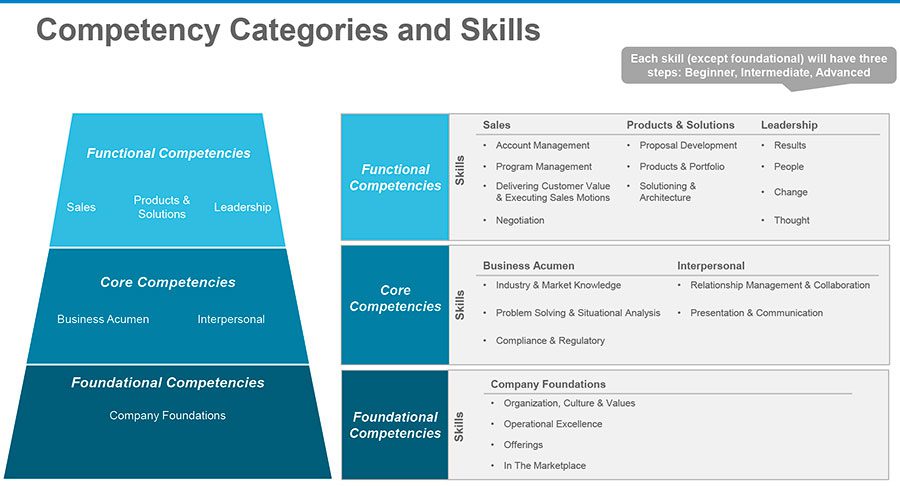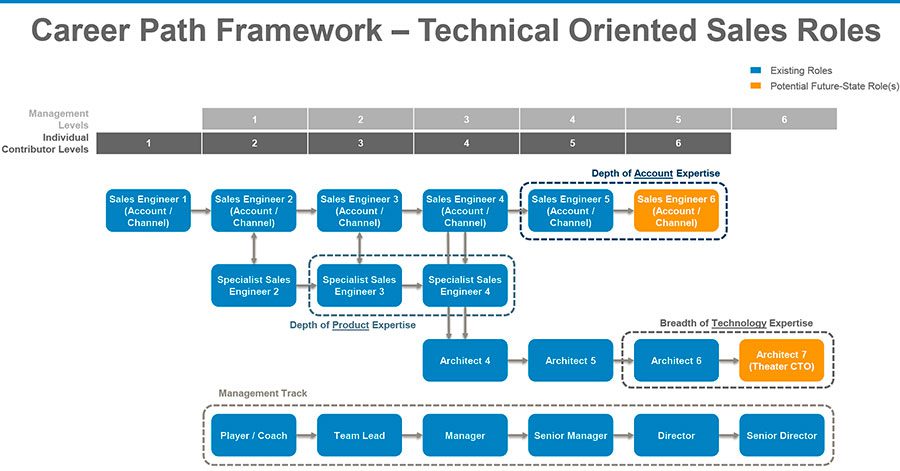Attracting/Retaining Sales Talent Using Career Paths and Competencies

Tech companies invest to attract and retain sales talent.
Leading technology companies are updating their sales compensation packages and investing in training and enablement to attract and retain sales talent and to counter the “Great Resignation.” However, many are overlooking other issues that are important to their employees, particularly, a lack of a clear and comprehensive job architecture—jobs, leveling and competencies—that creates a culture of meritocracy and allows an employee to see and understand a clear career path.
Alexander Group recently worked with a tech company that was facing higher than normal churn, specifically in their sales organization. To combat this, the company adjusted pay levels to industry benchmarks and made significant investments in training and enablement. However, upon further investigation, Alexander Group uncovered that the company recently made numerous go-to-customer changes in their coverage model and role definitions without developing competencies, career paths and leveling frameworks to align with updated roles and responsibilities. Individuals in impacted sales roles expressed lack of clarity for their growth trajectory within the company and/or a feeling of insecurity about the criteria for advancement. Many employees left for other companies that offered a clearer career path and in exit interviews often specifically stated it wasn’t just for higher pay.
The Solution: Job Architecture
Working with Alexander Group, the company identified the need to develop a job architecture which included job profiles, leveling within each job, aligned competencies and career path framework. Alexander Group interviewed and conducted workshops with sales leaders across different levels and all regions to ensure design was globally consistent, regionally applicable and strove for broad stakeholder involvement in discovery and design phases to smoothen eventual change management.
Step 1: Build Job Profiles with Levels
To create the required job architecture, Alexander Group first created standardized job profiles for various sales roles. Clear expectations such as typical time in role, performance, competency expectations, and training and certifications were laid out for each level within a specific role. This went beyond typical job profile information such as key job activities, ILAER focus, segments and verticals covered, generalized qualifications, etc. Levels were designed to capture the typical promotion path within a specific role.
Step 2: Design Competency Framework and Assigned Competencies to Jobs
Once the profiles were set, Alexander Group created a competency framework with skills needed in various jobs and levels. Skills were grouped into foundational, core, and functional competencies. All roles were required to have skills under foundational competencies such as knowing the products offered by the company. These skills were designed to only have one step.
Conversely, skills that fell under core and functional competencies were designed to have three steps, which differentiated jobs and job level expectations. For example, a sales development representative role was only expected to have step one under presentation and communication skill across all job levels. On the other hand, sales engineers conducting customer demos were expected to have steps one through three for the same skill, based on job level.
Skills under functional competencies were the most complex and applied to only a specific set of roles. For example, accounts managers were required to have negotiation skills, but not solutioning and architecture. On the other hand, technical roles such as sales engineers and sales architects were required to have solutioning and architecture skills, but not always negotiation skills.

Step 3: Create Career Path Framework
The final step was to design typical career paths for each role showing potential for upward movement within a job or lateral career shifts across jobs. Career paths also included options to grow as an individual contributor or to move into management role. Highlighting various opportunities within the company for an individual to grow using a visual depiction is impactful both during recruiting and retaining existing talent.

Implementation & Summary
The company recently began implementing Alexander Group’s job architecture and execution plan. As a first step, they are assessing all individual contributors and mapping them to skills and job level by conducting multiple workshops with managers across all regions. This is also helping the company update learning and development coursework as it identifies talent gaps relative to needs. Next, they will establish pay ranges by jobs and levels, and develop a consistent method for handling incumbents who are either over or underpaid based on slotted levels. Finally, the company will develop a communication and change management plan prior to rollout. Senior leadership is confident this will help alleviate recent churn issues.
Have you noticed job architecture (job profiles, leveling within each job, competencies and career path framework) as a key factor limiting your ability to attract and retain talent? Contact the Alexander Group Technology practice to learn how Alexander Group can help.
___________________________________________________
Not What You Were Looking For? Explore More…
Recommended Insights:
XaaS Customer Success Manager Part I: CSM Job Definition
XaaS Customer Success Managers Part II: Deployment
XaaS Customer Success Managers Part III: Compensation